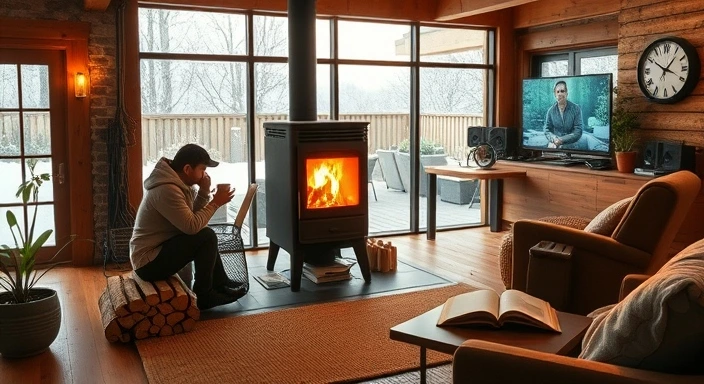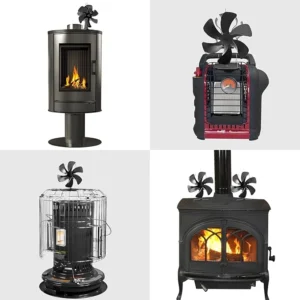A wood burning stove indoor is an efficient and charming way to heat your home while adding a rustic touch to your interior. However, using a wood burning stove indoors safely and effectively requires knowledge and proper preparation. In this guide, we’ll walk you through everything you need to know about using a wood burning stove indoor, from preparation to maintenance, ensuring your experience is both safe and enjoyable.
Preparing Your Wood Burning Stove Indoor for Use
Before lighting your wood burning stove indoor, it’s essential to ensure it is ready for operation. Proper preparation will maximize efficiency and minimize risks.
- Inspect the Stove and Chimney:
- Check the chimney for blockages, such as creosote buildup or debris.
- Inspect the stove’s gaskets and seals to ensure they are intact.
- Clean the Stove:
- Remove any leftover ash from previous use to allow proper airflow.
- Clean the glass door using a stove-specific cleaner for clear visibility.
- Gather the Right Materials:
- Use dry, seasoned hardwood for fuel to ensure a clean and efficient burn.
- Have kindling and fire starters ready to help ignite the fire.
- Ensure Proper Ventilation:
- Open the air vents on the stove to allow airflow.
- Check that your carbon monoxide detector is functioning properly.
Lighting Your Wood Burning Stove Indoor
Lighting a wood burning stove indoor is a straightforward process, but it requires careful attention to ensure safety and efficiency. Follow these steps:
- Open the Air Vents:
- Fully open the stove’s air vents to promote airflow and help the fire start quickly.
- Arrange the Kindling and Logs:
- Place crumpled newspaper or fire starters at the bottom of the stove.
- Add small pieces of kindling on top, followed by larger logs.
- Light the Fire:
- Ignite the newspaper or fire starters with a match or lighter.
- Close the stove door partially to maintain airflow while the fire builds.
- Monitor the Fire:
- Once the fire is established, add more logs as needed.
- Adjust the air vents to control the burn rate and heat output.
Operating Your Wood Burning Stove Indoor Safely
Using a wood burning stove indoor requires adherence to safety practices to prevent accidents and ensure efficient operation.
- Maintain Proper Clearance:
- Keep furniture, curtains, and other flammable items at least three feet away from the stove.
- Avoid Overloading the Stove:
- Adding too much wood at once can reduce efficiency and increase the risk of smoke buildup.
- Monitor the Temperature:
- Use a stove thermometer to ensure the fire is burning at an optimal temperature.
- Avoid overheating, which can damage the stove and chimney.
- Never Leave the Stove Unattended:
- Always supervise the fire when it is burning.
- Ensure the fire is completely out before going to bed or leaving the house.
Maintaining Your Wood Burning Stove Indoor
Regular maintenance is crucial to the longevity and efficiency of your wood burning stove indoor. Here are some essential tips:
- Clean the Stove Regularly:
- Remove ash buildup frequently to maintain airflow.
- Clean the glass door to prevent soot from obscuring the view of the fire.
- Inspect the Chimney:
- Schedule an annual chimney inspection to check for blockages or creosote buildup.
- Hire a professional chimney sweep if necessary.
- Check for Wear and Tear:
- Inspect gaskets, seals, and air vents for signs of damage.
- Replace any worn components to maintain efficiency.
- Burn the Right Wood:
- Use seasoned hardwood with a moisture content below 20% to minimize smoke and creosote.
Enhancing the Experience of Your Wood Burning Stove Indoor

A wood burning stove indoor is not just a heating appliance; it’s a centerpiece of comfort and ambiance. Here are some ways to enhance your experience:
- Use Heat-Powered Fans:
- These fans distribute heat evenly throughout the room without using electricity.
- Invest in Firewood Storage:
- Keep your firewood organized and within reach with a stylish storage solution.
- Add Decorative Accessories:
- Complement your stove with tools like a decorative screen, hearth pad, or log holder.
- Incorporate Eco-Friendly Practices:
- Recycle wood ash as a garden fertilizer.
- Choose sustainably sourced firewood to reduce your environmental impact.
Troubleshooting Common Issues with Wood Burning Stoves
While a wood burning stove indoor is reliable, you may encounter occasional problems. Here’s how to address some common issues:
- Smoke Entering the Room:
- Ensure the air vents are open and the chimney is clear of blockages.
- Check if the wood is too wet or the stove is overloaded.
- Difficulty Lighting the Fire:
- Use smaller kindling and ensure the wood is dry and well-seasoned.
- Confirm there’s enough airflow by opening vents or slightly cracking a window.
- Excessive Creosote Build-Up:
- Burn wood at higher temperatures to reduce creosote formation.
- Schedule regular chimney cleanings to prevent buildup.
- Low Heat Output:
- Use hardwoods like oak or maple for longer and hotter burns.
- Ensure the stove is properly sealed to prevent heat loss.
Advanced Tips for Using a Wood Burning Stove Indoors
For seasoned users of wood burning stoves indoor, these advanced tips can help you get even more out of your appliance:
- Optimize Airflow:
- Experiment with vent adjustments to find the most efficient burn settings for your stove.
- Zone Heating:
- Use your stove to heat specific areas of your home and reduce reliance on central heating.
- Monitor Firewood Quality:
- Invest in a moisture meter to ensure your wood is properly seasoned.
- Install a Heat Shield:
- Protect walls and furniture with a heat shield, allowing you to place the stove closer to other objects safely.
- Utilize a Stove Top Thermometer:
- Monitor the stove’s surface temperature to maintain optimal burning conditions and prevent overheating.
Creating a Cozy Atmosphere with Your Wood Burning Stove Indoor
A wood burning stove indoor can be the heart of your home, creating a cozy and inviting atmosphere. Here are some ideas:
- Set Up a Comfortable Seating Area:
- Arrange chairs or a sofa near the stove for a warm gathering spot.
- Add Soft Lighting:
- Use dim lighting or candles to enhance the ambiance of the flickering firelight.
- Decorate with Natural Elements:
- Incorporate wood, stone, or greenery to complement the stove’s rustic appeal.
- Seasonal Decor:
- Change decorations around the stove to reflect the seasons, such as autumn leaves or winter garlands.
Expanding Your Knowledge on Wood Burning Stoves
If you want to dive deeper into the world of wood burning stoves indoor, consider exploring these topics:
- Energy Efficiency:
- Learn how to maximize the heat output of your stove while minimizing wood consumption.
- Eco-Friendly Practices:
- Research ways to make your stove usage more sustainable, such as using renewable firewood sources.
- Stove Design Trends:
- Discover modern designs and features that can enhance both functionality and aesthetics.
- Local Regulations:
- Stay informed about local laws and guidelines regarding wood stove installation and operation.
Additional Safety Considerations for Indoor Wood Burning Stoves
When using a wood burning stove indoor, taking extra precautions can enhance safety for your household. Here are some additional safety measures to keep in mind:
- Install a Spark Screen:
- Use a spark screen to prevent embers from escaping the stove and causing accidental fires.
- Keep a Fire Extinguisher Nearby:
- Always have a fire extinguisher within reach, and ensure it’s suitable for wood and ash fires.
- Child and Pet Safety:
- Use a safety gate or barrier around the stove to protect children and pets from burns.
- Regularly Test Smoke Detectors:
- Test your smoke detectors monthly to ensure they are functioning properly.
- Use a Stovepipe Thermometer:
- Monitor the stovepipe’s temperature to prevent overheating and reduce creosote buildup.
Tips for Prolonging the Life of Your Wood Burning Stove
A well-maintained wood burning stove indoor can last for decades. Here are some tips to extend its lifespan:
- Use Only Approved Fuels:
- Avoid burning treated wood, trash, or other materials that can damage the stove or produce toxic fumes.
- Inspect the Door Seals:
- Ensure the door seals are tight to prevent air leaks that can reduce efficiency.
- Schedule Professional Maintenance:
- Hire a professional to inspect and maintain your stove annually to address potential issues early.
- Store Firewood Properly:
- Keep firewood dry and off the ground to prevent rot and ensure a consistent burn.
Conclusion
Using a wood-burning stove indoors is a practical and aesthetically pleasing way to heat your home while creating a cozy atmosphere. However, safety, preparation, and maintenance are essential for ensuring optimal performance and avoiding risks. From choosing the right wood to installing safety measures and keeping the stove clean, every step contributes to a better and safer experience. By following the guidelines outlined in this post, you can enjoy the warmth and charm of a wood-burning stove for years to come while maintaining a safe and comfortable indoor environment.






